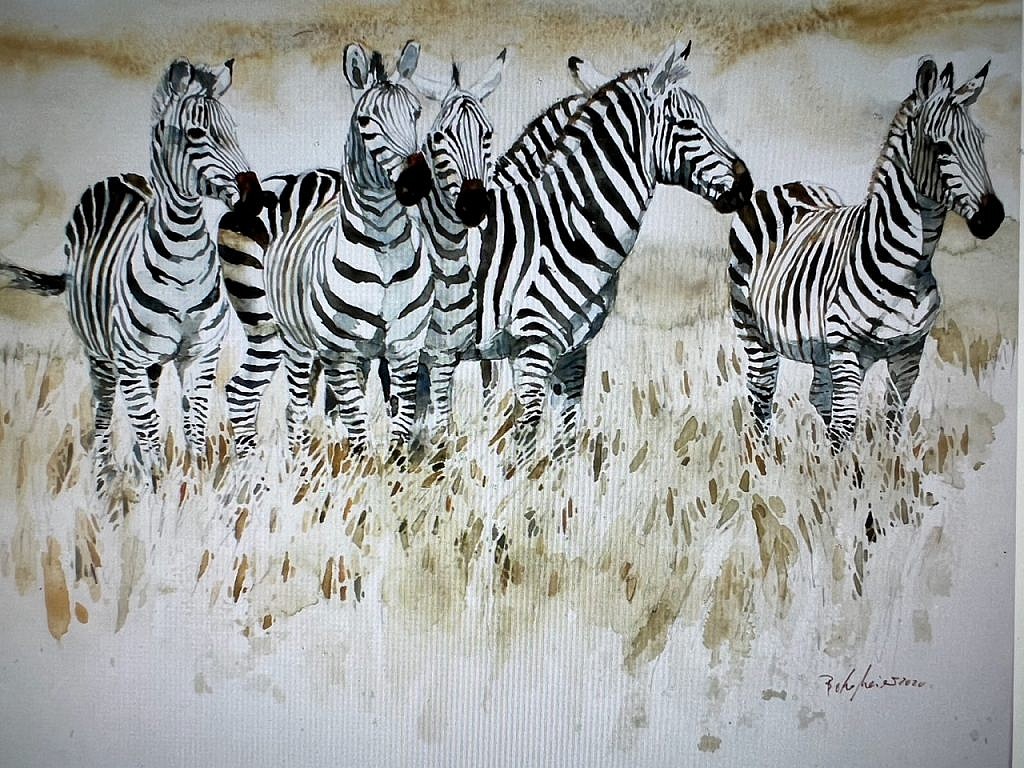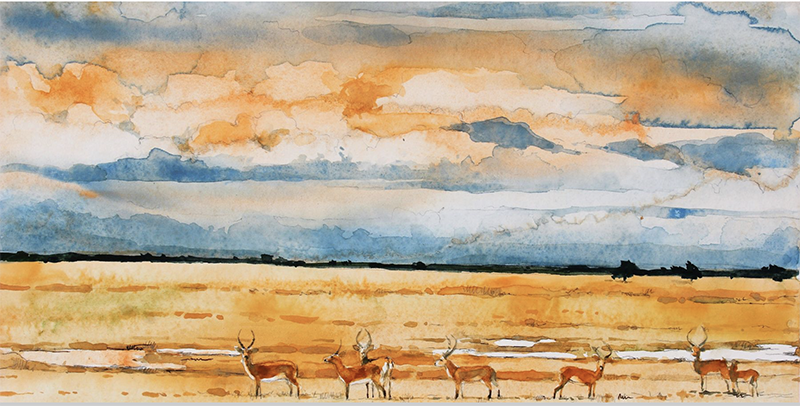
by Brooke Chilvers
It’s terrible when a journeyman actor, after decades of hard work, suddenly snatches the perfect role at the perfect time and shoots to fame with a stream of Golden Globes, Screen Actors Guild Awards, and Emmys, only to unexpectedly expire at the very top of their game. Think Nancy Marchand (1928–2000) who played Livia Soprano, Tony’s impossible mother, for two seasons in the HBO series, The Sopranos. Instead of glorying in her deserved success, they had to kill her off in the third-season script. Don’t even mention James Gandolfini himself. He dropped stone dead, at 51, of a heart attack in a hotel room in Rome at the height of his soaring career. (We’ll skip the prematurely overdosed John Belushi, Heath Ledger, Philip Seymour Hoffman, etc.)
So it hit hard when conservationist and author Rolf Baldus informed me that German wildlife artist Bodo Meier (b. 1949), whom I’ve written about several times, had passed away only days before the opening of his career-topping exhibition in Munich, Wildleben Afrikas (African Wildlife), at Germany’s premier hunting museum, Deutsches Jagd- und Fischereimuseum München.

For anyone who knew Bodo, or enjoyed his works, or owned his lovely calendars, this show, featuring many of his finest African watercolors, serves as a celebration of his well-lived life. The exhibit continues until April 30, 2024.
As a kid, Bodo drew on every blank piece of paper within reach, and loved excursions to the Hannover zoo to sketch, especially feline predators. He pored over the color plates and fuzzy black and white photos in classic reference books, such as Brehms Tierleben and Grizimek’s Animal Life Encyclopedia. As an artist, he considered himself a student of 19th century German wildlife artists Richard Friese and Friedrich Wilhelm Kuhnert. But a more important influence on his vision originated with his art instructor, watercolorist and Jagdmaler (hunting artist) Willi Schütz (1914–1995), whose bold colors and brushstrokes express his subjects moving impressionistically through a landscape. He also inspired Bodo, at age 40, to return to university to further develop his skills in field identification, comparative anatomy, and scientific drawing.

Meier started out painting Europe’s indigenous game species in zoological gardens, and from high seats and postings during driven or stalking hunts for wild boar, roe deer, red stag, hare, and fox. Hunted specimens also provided the opportunity for close-up study, photography, measurement and sketching, and dissection, which are off limits to urban artists. Bodo started traveling to Africa in 1996, mostly Tanzania, and mostly the Selous, although he knew well Lake Manyara, the Ngorongoro Crater, and the Serengeti; he accompanied rhino-tracking game scouts, and roamed along the Rufiji, Ruaha, Ulanga, and Kilombero rivers.
The result of his numerous painting safaris is two books, Mal Reise in die Serengeti—a Painting Journey in the Serengeti—and Serengeti Lebt—Serengeti Lives. He also illustrated Baldus’s 2009 book on the history and heritage of the Selous, Wild Heart of Africa, and for years produced a popular, collectible wildlife calendar. Although he did not paint hunting scenes, Bodo was a regular contributor to German hunting magazines, such as Wild und Hund.

With university degrees in both science and art, Bodo was as much a biologist and naturalist as he was an artist, and as much a teacher of art, biology, and chemistry, too. His took his art students on field trips to paint the bucolic landscapes and wildlife of Bavaria, Sweden, and the Swiss Canton of Aargau. Alongside instruction in painting with the simple, portable tools for watercolors en plein air, he encouraged their observation and field identification of everything around them. He’d recently added trips to Namibia’s Kalahari Desert, where his students could study everything from impala to white rhino, as well as all the “little stuff,” from weavers’ nests to termite hills.
Bodo was the opposite of the photorealistic wildlife artist. He liked to let go of his watercolors, to let them “have a life of their own.” Watercolors, he said, allowed him to employ a wider range of less realistic colors, to exaggerate the impression (rather than a portrait) of a family of giraffe, to use purple violet in his tawny lions. His beautifully executed watercolors clearly distinguish between umbrella acacias and fever trees. His brilliant morning glories and bright yellow monkey pod flowers remind us that Africa is more than “just dust, dust and dust,” he said, and that “its blue skies and colorful flowers require cerulean blue and carmine.” Whether a herd of bison or chamois splashing through the snow, Bodo’s light-infused transparent colors amazingly become the species’ natural environment.

I first met the kind-eyed, shaggy-haired artist on a wintry December night in the Baldus home on the edge of the Siebengebirge Nature Reserve, southeast of Bonn, back in 2013. He arrived heavily laden with a fully cooked dinner of red deer Jägerragout, potato dumplings, and red cabbage to accompany Rolf’s good Bordeaux. Our Peugeot 407 was buried over the wheels in snow, and it was quite a job and lots of laughs digging us out the next day.

We have snow tires on our car now, and were looking forward to a winter trip visiting old friends and landscapes east of the Rhine. I thought we would meet Bodo Meier again. To feast, drink, and look at new paintings. Instead, if you are anywhere near Munich in the months to come, please visit Bodo’s exhibition. His unique African safari costs only the price of an entry ticket.
Mungu alaze roho ya mzee mahali pema peponi, Bodo!
Brooke Chilvers is celebrating twenty years as art critic and columnist for Gray’s Sporting Journal.
